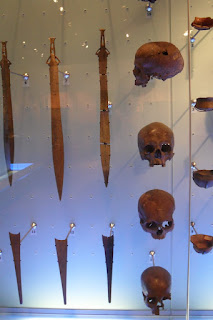 Photo courtesy of http://www.vam.ac.uk/moc/your_visit/index.html
Photo courtesy of http://www.vam.ac.uk/moc/your_visit/index.htmlMost displays start with text explaining the relevance of toys as learning devices. It was amazing to see the progression of toys through the last few hundred years. What was most interesting to me, is that toys have not changed much! Children still play with the same type of things, and in a very similar way! The only things that have changed are the materials, sometimes shape and design, and basic manufacturing.
 This is an example of how some items and concepts are displayed. The display case explains the importance of toys not only for amusement but for their inherent learning qualities. This is a great learning museum for children as it encourages them to actively think about the displays, not just passively view them. Inside most displays were plaques with analytical questions to get people thinking more in depth about the exhibit. Engaging children in active learning sets them up to appreciate the museum because they are truly considering the items on display. Some displays ask them to examine items, imagine concepts, or simply encourage creative learning.
This is an example of how some items and concepts are displayed. The display case explains the importance of toys not only for amusement but for their inherent learning qualities. This is a great learning museum for children as it encourages them to actively think about the displays, not just passively view them. Inside most displays were plaques with analytical questions to get people thinking more in depth about the exhibit. Engaging children in active learning sets them up to appreciate the museum because they are truly considering the items on display. Some displays ask them to examine items, imagine concepts, or simply encourage creative learning.
Part of the exhibit displayed common items like old highchairs, baby bottles; the basics needed for caring for a child. Some of them, like the bottle, were barely recognizable. It was interesting to see the change, and I think children would really find this funny. The picture above is asking visitors to actively think about how items familiar to them have changed through time. It is different when you read about history-you have to paint your own pictures or look at one in a book. By being able to compare a very old bottle to what a child would recognize as a bottle today, it's easier to see the progress that was made and it becomes more memorable. That's the beauty of a museum.
Children can also participate in daily events and seasonal activities. According to their website, they have an "excellent education programme with popular teaching sessions and resources linked directly to the National Curriculum".
This display was successful in showing the timeline of fashion for children from the 1750s until today. My only issue with it was that I don't think it accurately portrayed the current fashion for children today-however it is 2009 and the trends are constantly changing. Then again, if they pick one outfit to represent the 2000s and it seems misrepresented-who is to say the other outfits do justice for their time? That, I will have to leave in the trained hands of these professionals.

History of the museum:
In 1855 Prince Albert proposed the construction of a building in South Kensington to house items from the Great Exhibition of 1851. This exhibit is what made libraries and museums gain popularity with the general public. The iron structure of the Museum of Childhood building was once part of the original V&A Museum. It was transported to Bethnal Green, its current home, and reconstructed in the late 1860s. I found it interesting that the marble floor was made by women prisoners from Working gaol. The Prince and Princess of Wales (later King Edward VII and Queen Alexandra) opened the museum in 1872. 1.5 million visitors had passed through the doors in it's first year of operation! The original collection consisted of food, animal products, and French art from the 1700s. It was not until Arthur Knowles Sabin was the Officer-in-charge from 1922-1940 that the collection was directed towards children. Activities, children's visits, educational programs and displays were all developed to cater to children. Donors generously helped to fund this project, one of them being Queen Mary.
Their site is very fun, take a virtual tour!! Go to http://www.vam.ac.uk/moc/






 National Art Library
National Art Library



















 St. Paul's Cathedral has existed in one form or another at this site for about 1,400 years. Walk up the beautiful spiral staircase (picture the Harry Potter staircase!) and behind closed doors is a fantastic old library-closed to the public. Unlock with a great, old fashioned key and enter a world of incredibly preserved books and the classic smell of an old library. The library at St. Paul's Cathedral was seriously impressive and left me in awe. The Great Fire of 1666 destroyed the original collection, however it was built up again starting in 1712. The image here, obtained from
St. Paul's Cathedral has existed in one form or another at this site for about 1,400 years. Walk up the beautiful spiral staircase (picture the Harry Potter staircase!) and behind closed doors is a fantastic old library-closed to the public. Unlock with a great, old fashioned key and enter a world of incredibly preserved books and the classic smell of an old library. The library at St. Paul's Cathedral was seriously impressive and left me in awe. The Great Fire of 1666 destroyed the original collection, however it was built up again starting in 1712. The image here, obtained from 
